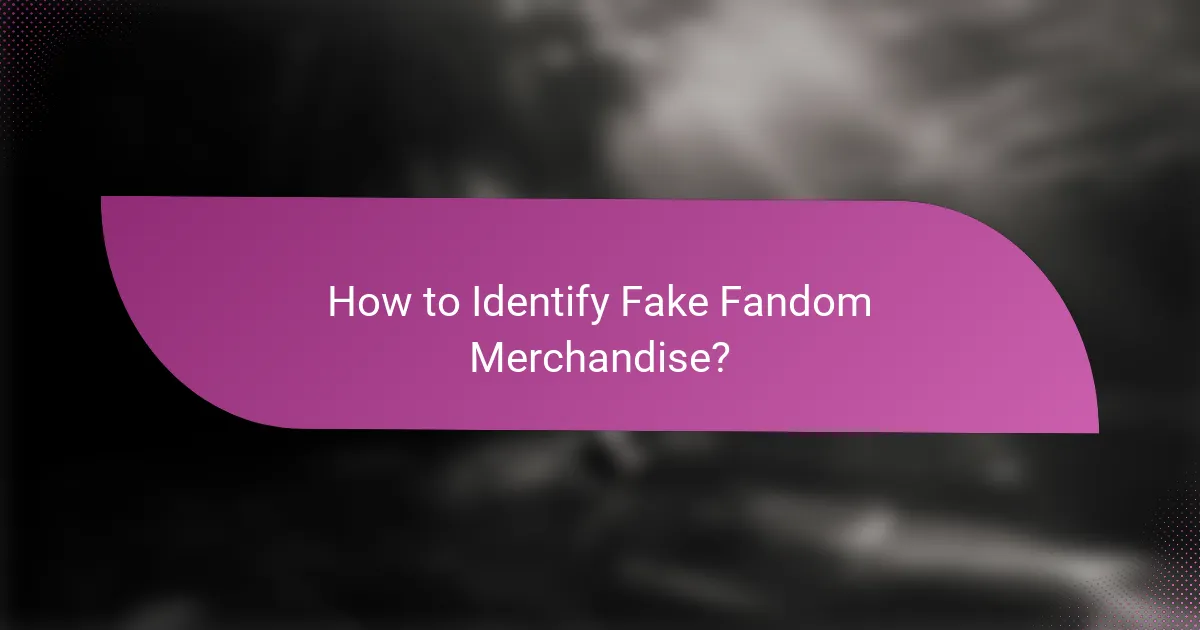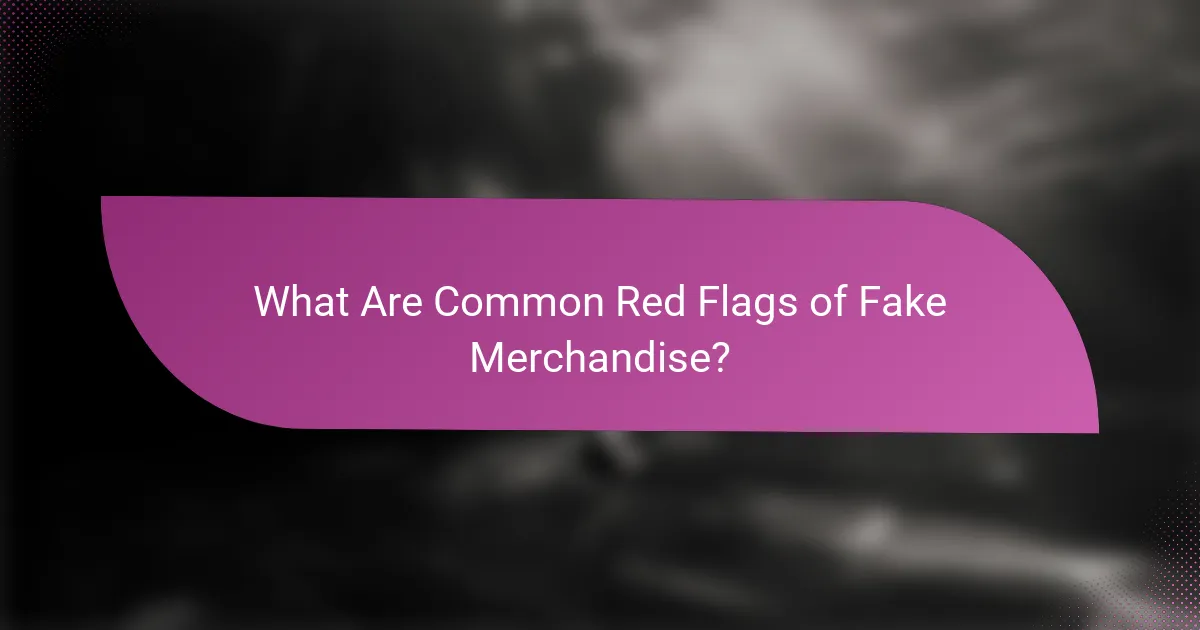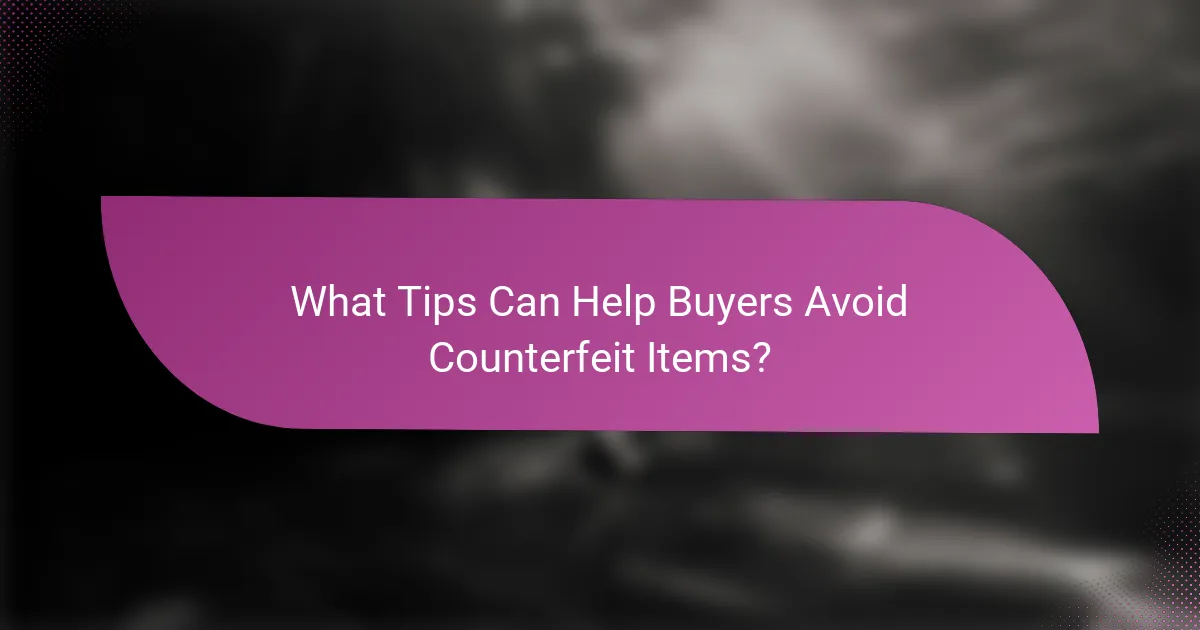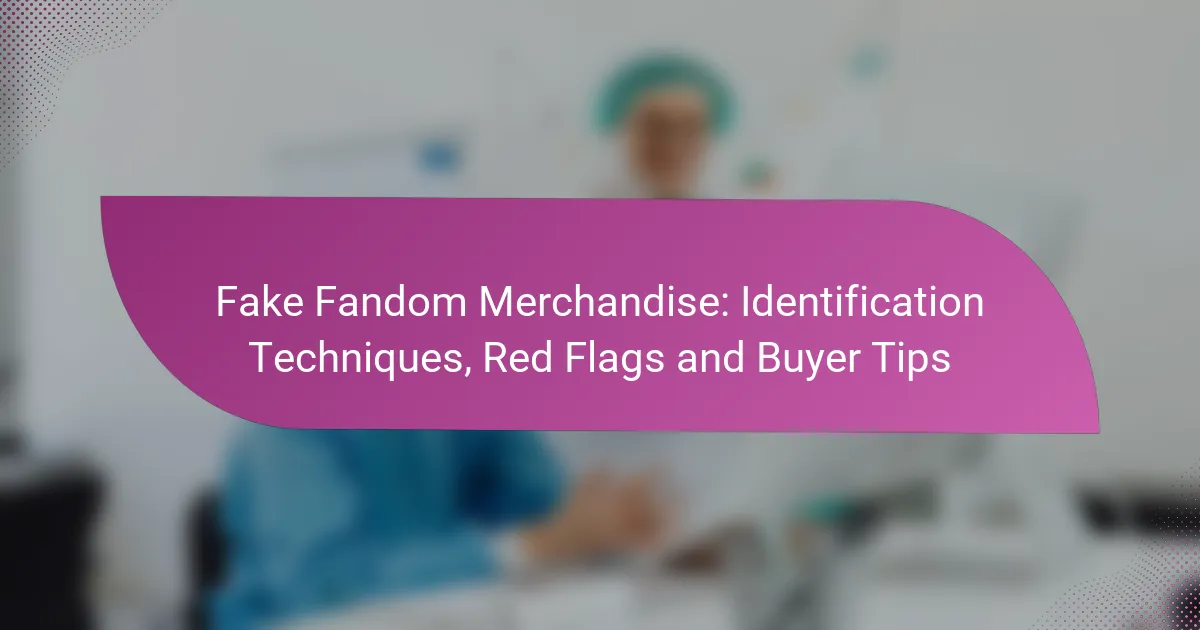In the world of fandom merchandise, distinguishing between authentic items and counterfeits is crucial for collectors and fans alike. By understanding key identification techniques, recognizing common red flags, and following buyer tips, enthusiasts can protect themselves from purchasing fake products. Ensuring authenticity not only enhances the value of a collection but also supports the creators behind beloved franchises.

How to Identify Fake Fandom Merchandise?
Identifying fake fandom merchandise involves checking for authenticity markers that distinguish genuine products from counterfeits. Key techniques include verifying official licensing, assessing product quality, and reviewing seller reputation.
Check for official licensing
Officially licensed merchandise typically displays a licensing logo or tag, indicating that the product has been authorized by the original creators. Look for recognizable logos from companies like Disney, Warner Bros, or other relevant franchises.
Counterfeit items often lack these marks or have poorly printed versions. If you can’t find any licensing information, it’s a red flag that the merchandise may not be legitimate.
Examine product quality
Genuine fandom merchandise usually meets certain quality standards, including durable materials and precise craftsmanship. Check for stitching, print clarity, and overall finish; authentic products are generally well-made.
If the item feels flimsy or has noticeable defects, it may be a counterfeit. Comparing the quality with similar items from official retailers can provide a good benchmark.
Review seller reputation
Before purchasing, research the seller’s reputation through reviews and ratings on platforms like eBay, Amazon, or specialized fandom sites. A seller with a high rating and positive feedback is more likely to offer authentic merchandise.
Be cautious of sellers with numerous complaints or a lack of reviews. If the seller is new or has a questionable history, consider looking for alternatives.
Look for packaging details
Authentic merchandise often comes with high-quality packaging that includes branding and product information. Check for details like holograms, barcodes, and care instructions that are typically present on official items.
Counterfeit products may have generic or poorly designed packaging. If the packaging seems off or lacks essential details, it’s worth reconsidering your purchase.
Compare prices with official retailers
Prices for genuine fandom merchandise usually fall within a specific range. If a deal seems too good to be true—like a brand-name item priced significantly lower than the average market price—it’s likely a counterfeit.
Check official retailers or authorized resellers to establish a price baseline. If you find a product priced well below this range, approach with caution and verify its authenticity before buying.

What Are Common Red Flags of Fake Merchandise?
Common red flags of fake merchandise include poor print quality, missing brand logos, inconsistent sizing, unusual materials, and the absence of care instructions. Identifying these indicators can help buyers avoid counterfeit products and ensure they receive authentic fandom merchandise.
Poor print quality
Poor print quality is a significant indicator of fake merchandise. Authentic products typically feature sharp, vibrant graphics, while counterfeit items may have blurry images or faded colors. Inspecting the clarity and detail of the print can reveal whether the merchandise is genuine.
Look for inconsistencies in the printing, such as smudges or misalignment. If the design appears pixelated or lacks the expected detail, it is likely a fake.
Missing brand logos
Missing brand logos are another telltale sign of counterfeit merchandise. Legitimate products usually display official logos prominently, while fakes may omit them entirely or use incorrect versions. Always check for the presence and accuracy of logos on the item.
If you notice a product lacking the expected branding or featuring a logo that looks different from the official one, it is advisable to question its authenticity.
Inconsistent sizing
Inconsistent sizing can indicate fake merchandise, as authentic items typically adhere to standard sizing charts. Counterfeit products may vary significantly in size, making it difficult to find the right fit. Always compare the sizing with official brand specifications.
When purchasing clothing or accessories, refer to the brand’s size guide and measure the item if possible. If the sizing seems off, it could be a red flag.
Unusual materials used
Unusual materials used in merchandise can signal that an item is not genuine. Authentic products are made from high-quality materials that match the brand’s standards, while fakes may use cheaper, inferior materials. Pay attention to the texture and feel of the item.
For example, if a t-shirt feels scratchy or thin compared to similar authentic products, it may be a counterfeit. Always research the expected materials for the item you are considering.
Absence of care instructions
The absence of care instructions is a common red flag for fake merchandise. Genuine products usually come with clear care labels that provide washing and maintenance guidelines. If these instructions are missing or poorly printed, it may indicate a counterfeit item.
Check for care tags and ensure they contain proper information. If you find a product without care instructions or with vague details, it is wise to be cautious about its authenticity.

What Tips Can Help Buyers Avoid Counterfeit Items?
To avoid counterfeit items, buyers should be proactive by conducting thorough research, purchasing from trusted sources, and verifying authenticity. These steps can significantly reduce the risk of acquiring fake fandom merchandise.
Research before purchasing
Before making a purchase, it’s crucial to research the item and its typical characteristics. Familiarize yourself with the official branding, logos, and packaging of the merchandise to spot discrepancies. Look for reviews and feedback on the product and seller to gauge reliability.
Utilize online resources, including official websites and fan communities, to gather information about the product. This knowledge can help you recognize genuine items versus counterfeits.
Buy from reputable sources
Purchasing from well-known retailers or official merchandise stores is one of the safest ways to avoid counterfeit items. Established sellers often have strict quality control measures in place to ensure authenticity.
Be cautious with online marketplaces where individual sellers can list items. Check the seller’s ratings and reviews, and prioritize those with a proven track record of selling genuine merchandise.
Ask for authenticity certificates
Request authenticity certificates or proof of origin when buying high-value items. These documents serve as verification that the merchandise is genuine and often include details about the item’s production.
Be wary if the seller is unwilling to provide such documentation, as this could be a red flag indicating potential counterfeit goods.
Utilize community forums
Engaging with fandom communities can provide valuable insights and advice on spotting counterfeit merchandise. Many fans share their experiences and tips on forums, helping others avoid pitfalls.
Participate in discussions or seek recommendations for trusted sellers within these communities. This collective knowledge can be a powerful tool in your purchasing decisions.
Check return policies
Before finalizing a purchase, review the seller’s return policy. A clear and fair return policy indicates that the seller stands behind their products and is likely to offer genuine merchandise.
Be cautious of sellers with no return options or overly restrictive policies, as these can be signs of counterfeit operations. Knowing you can return an item if it turns out to be fake provides additional peace of mind.

What Are the Best Platforms for Authentic Merchandise?
The best platforms for authentic merchandise include official brand websites, authorized retailers, and reputable online marketplaces. These platforms ensure that the products you purchase are genuine and meet quality standards.
Official brand websites
Official brand websites are the most reliable sources for authentic merchandise. They typically offer a full range of products directly from the brand, ensuring quality and authenticity. When shopping, look for secure payment options and clear return policies.
To verify you’re on an official site, check for a secure connection (https://) and look for contact information or customer service options. Brands often provide exclusive merchandise or limited editions that are only available through their websites.
Authorized retailers
Authorized retailers are third-party sellers that have permission from brands to sell their merchandise. These retailers often have physical stores or online shops that are recognized by the brand. Buying from these sources can provide a wider selection of products.
Before purchasing, confirm that the retailer is listed on the brand’s official website as an authorized seller. This can help avoid counterfeit products. Look for customer reviews and ratings to gauge the retailer’s reliability.
Reputable online marketplaces
Reputable online marketplaces, such as Amazon or eBay, can offer authentic merchandise, but caution is necessary. Always check seller ratings and reviews before making a purchase. Look for listings that are marked as “official” or “verified” by the platform.
When shopping on these platforms, be aware of return policies and buyer protections. If a deal seems too good to be true, it often is; compare prices with official sites to ensure you’re not being misled.
